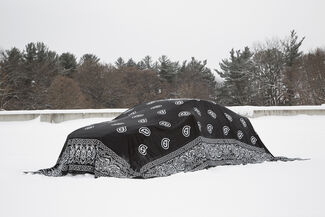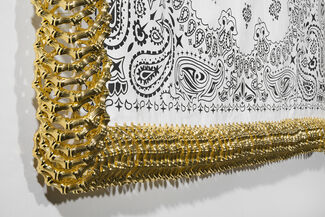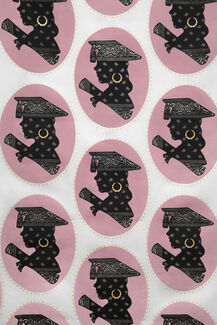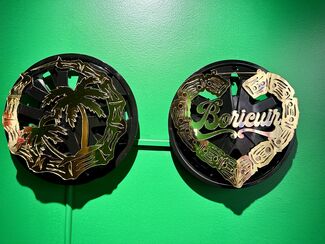
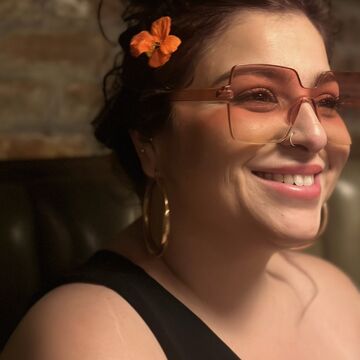
Vanessa Viruet
Lecturer
Contact
Bio
Vanessa Viruet (she/her) is a Chicago based fiber artist of Puerto Rican descent. She creates monumental scale artworks to examine the complex histories rooted in textiles such as identity, cultural heritage, gender and class. Viruet holds a BFA and a MA in Teaching from the Maryland Institute College of Art as well as an MFA from Cranbrook Academy of Art. Her art has been exhibited at the National Museum of Puerto Rican Arts and Culture and the Museum of Contemporary Art in Detroit. She currently serves as an art instructor for Chicago Public Schools and teaches in the Fiber and Material Studies Department at the School of the Art Institute of Chicago. Someday she hopes to have her own scholarship for artists of color.
Awards: Constructed Visions III, St. Louis Artist Guild, St. Louis, MO (2020); We Want As Much, Politits Arts Coalition, Rochester, NY (2020); AICAD fellowship nominee Second Year Merit Scholarship, Cranbrook Academy of Art (2018); Nita Billie Barak Memorial Merit Scholarship, Cranbrook Academy of Art (2017); Margaret Glace Merit Scholarship in Education, Cranbrook Academy of Art (2016); Best in Show Juried Undergraduate Exhibit, Maryland Institute College of Art (2009). Publications: LGBTQ+ Puerto Rican History, Activism, and Identity, Humboldt Park Gallery (2024); "Seeing / Being Seen: LGBTQIA+ Writers on LGBTQIA+ Fiber Artists," Surface Design Magazine (2023). Solo Exhibitions: Bebesota, Co-Prosperity Sphere Window Exhibition, Chicago, IL (2024); Perreo en el Parque, Comfort Station, Chicago, IL (2023); Pañuelx, New Harmony Center for Contemporary Art, New Harmony, IN (2022); Flagged George Caleb Bingham Gallery, Columbia, MO (2019); Where We Are, George Caleb Bingham Gallery Milwaukee, WI (2017); Que Bonita Bandera, Latin Street Dance Academy, Chicago, IL (2014). Group Exhibitions: Auto Portrait Spectacular, National Museum of Mexican Art, Chicago, IL (2024); Tierra y Libertad, Beloit College, Beloit, WI (2024); Liminal, National Museum of Puerto Rican Arts and Culture (2024); WEPA! A la Venta, El Schomburg Gallery, Chicago, IL (2024); Slow and Low Chicago Low Rider Festival Chicago, IL (2023); Aqui, Alla Walkers Point Center for the Arts, Milwaukee, WI (2023); 84/6: Labor Kansas City Missouri (2023); Citizen, Lubeznik Center for the Arts, Michigan City, IN (2023); Perreo en el Parque, Comfort Station, Chicago, IL (2023); Carrying the Thread, Chicago Textile Week Merchandise Mart, Chicago, IL (2022); Prairie Land, Monaco Saint Louis, MO (2021); Double Exposure, Roots and Culture Contemporary Art Center, Chicago, IL (2021); Deep, Far, Home, Chicago Textile Week, Epiphany Center for the Arts, Chicago, IL (2021); Car Culture, Orange County Center for Contemporary Art, Santa Ana, CA (2021); Constructed Visions III, St. Louis Artist Guild, St. Louis, MO (2020); We Want As Much, Politits Arts Coalition, Rochester, NY (2020); Entrelazar, Circle Contemporary, Chicago, IL (2019); Intimacy of Visibility, Acre Projects, Chicago, IL (2019); Standing Still, Lying Down, As If, Museum of Contemporary Art, Detroit, MI (2018); Future Tense, Surface Design Association, George Caleb Bingham Columbia, MO (2018); Transparent Factors, South Rotunda Gallery, Dekalb, IL (2018); First Annual Lowrider Festival, Pilsen, Chicago IL (2018); MFA Thesis Exhibit, Cranbrook Art Museum, Bloomfield Hills, MI (2018); Makers of Various Ethnicities (M.O.V.E), Forum Gallery, Bloomfield Hills, MI (2018); Experiencing Perspectives, Mercedes Benz F.S, Farmington Hills, MI (2017); American Dream, K Space Contemporary, Corpus Christi, TX (2017); Precarity: Contingency in Artmaking and Academia, Gallery 400, Chicago, IL (2016); Open Studios Exhibition, Bridgeport Art Center, Chicago, IL (2015); Master of Fine Arts in Teaching Graduate Thesis Exhibition, Baltimore, MD (2010); Undergraduate Thesis Exhibition, Decker Gallery, Baltimore, MD (2009); Eureka! Load of Fun Gallery, Baltimore, MD (2009); How Long Did That Take?, Rosenburg Gallery, Baltimore MD (2006); Exhibition, Aix-en-Provence, France (2005); Group Exhibition, Haggerty Museum of Art, Milwaukee, WI (2005).
Personal Statement
I feel like I am constantly straddling a border. Not quite Puerto Rican enough, American enough or Queer enough and my work is an attempt to understand those distinctions.
My current artistic practice is dedicated to material explorations and the language of flags. Research has led me to consider the connotations of flags in noun (flag) and verb form (flagging). This has brought me to the fringes of masculine culture––gang banging and gay cruising––where flags and flagging have a prominent role and where clothing has served as a subversive tool for expressing human relations.
In both gang and gay culture, the “feminine” patterned bandana fabric represents the act of identifying, or flagging, oneself. In gang culture, color is one of the most visible displays of allegiance to a particular gang. In the 1970s gay culture, bandanas were the basis for the "hanky code," a color-coded system for communication of sexual interests and fetishes.
Throughout history, bandanas and jewelry have served as symbolic representations of identity. From the early stages of life, hoop earrings have been a cherished adornment for many Latinas. As I transitioned into adulthood, wearing these earrings became a profound link to my Latina heritage, particularly as I maneuvered through predominantly white academic spaces.
I use the bandana as an example of socioeconomic cloth, a textile associated with class, gangs, and queerness, and a textile connected to my own history. By flagging and introducing this icon into a gallery setting, I seek to call attention to the vast space between the art world and various communities of so-called outsiders. Exaggerating the scale is a symbolic gesture of intervention, a way of colonizing and claiming my space in the world as a queer Latina from a barrio.
The value of art rests in its ability to communicate across barriers.
